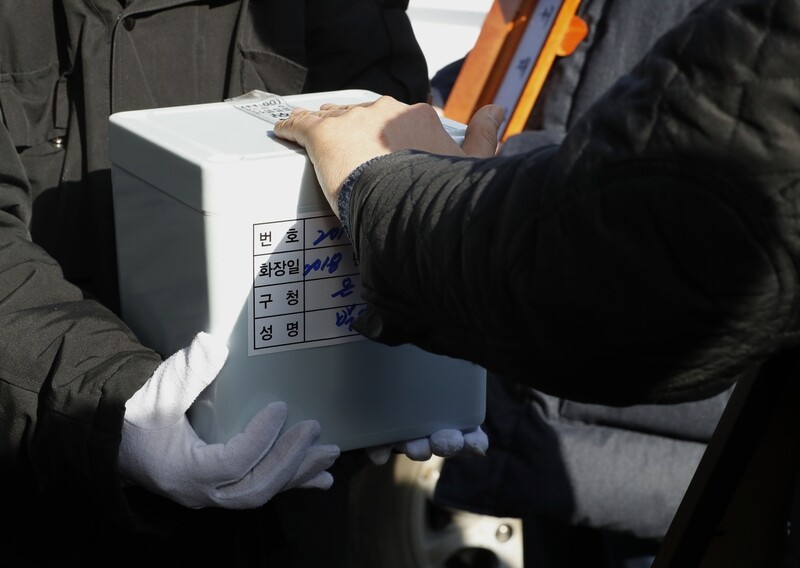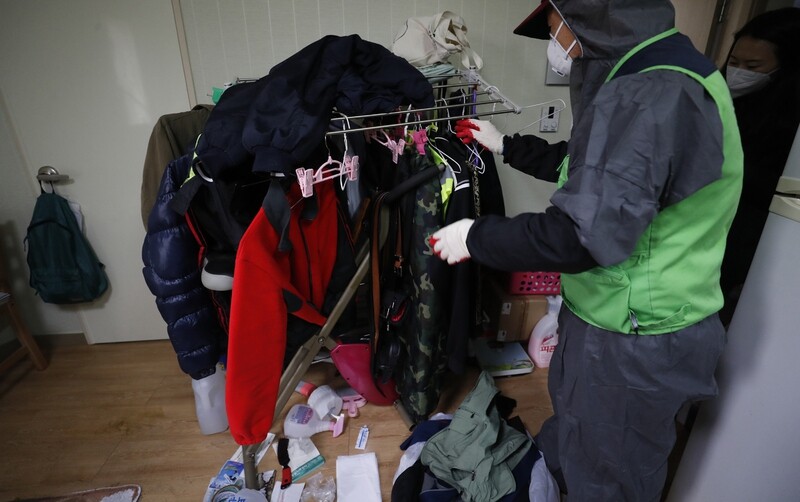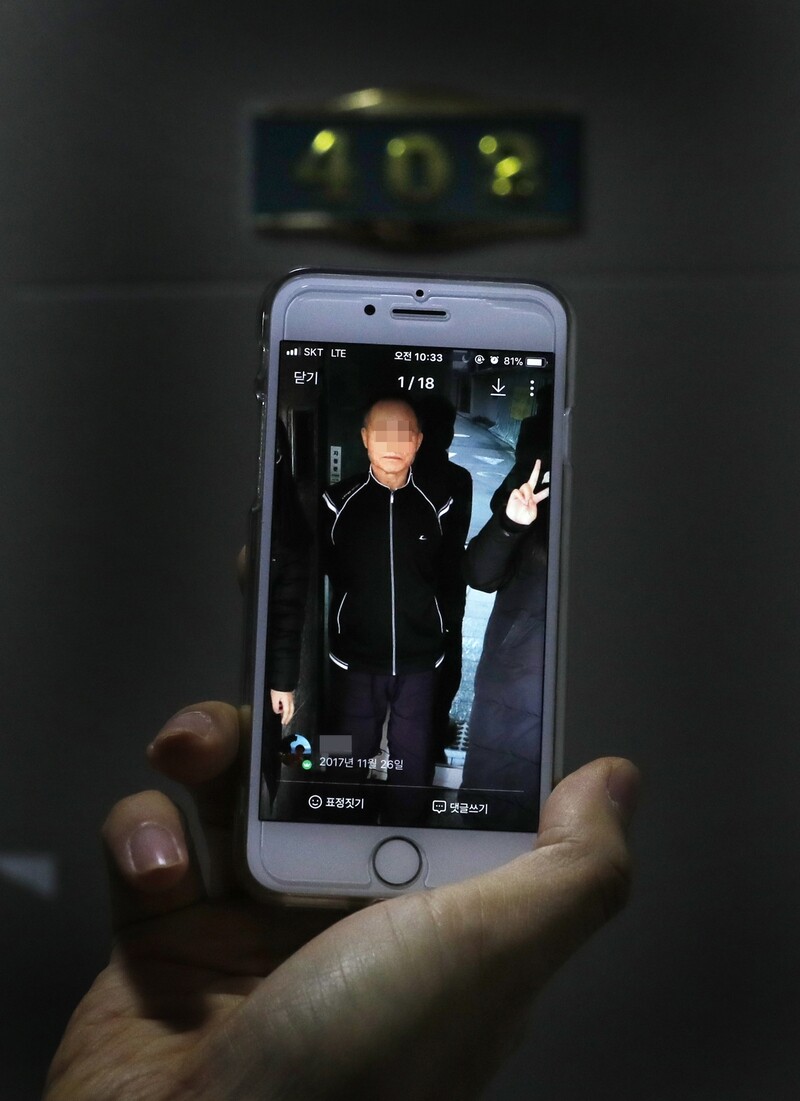hankyoreh
Links to other country sites 다른 나라 사이트 링크
[Reportage] A sad, solitary ending for victims of lonely death

On Jan. 19, a bell was tolling ceaselessly in the memorial area in front of Furnace No. 16 at the Seoul Municipal Crematorium and Cemetery. While the body was being cremated, thirty or so friends and relatives of the deceased kept crying. They shared their grief through hugs and caresses. After that, coffins rolled into Furnaces No. 17 and No. 18, and the green light blinked on, indicating that cremation had begun. Unlike the deceased in Furnace No. 16, these were cases of godoksa – a Korean word meaning the solitary death of someone who lives alone – and the bodies had been found several days after death. The emptiness of the memorial area in front of the furnaces suggested how lonely their lives had been. Despite their hardship, there was no one to remember them. They had been alone at the moment of death, and they remained alone until the moment their bodies disintegrated.
Furnace No. 17 contained the remains of Park Gi-ri, 64, whose body had been found on the fourth floor of a government-subsidized low-rise apartment in the Eunpyeong District of Seoul on Jan. 5. The medical examiner concluded that Park had already been dead for two weeks. He had been found on an electric floor pad, his limbs splayed out. A faded white T-shirt and gray thermal underwear covered his distended body. His bedding was black with fluid secreted from his decaying body. The reason his body had remained relatively intact was because the house was so cold. The gas bill for December delivered to his house at the end of January was only 15,092 won (US$14).
Park’s death was brought to light after two weeks by Lee Jeong-ha, 45, his next-door neighbor. Lee had said hi to Park one time after he moved there in 2017. She found it strange that rice provided by the government which was delivered at the end of Dec. 2017 remained in front of the door day after day, so she took a closer look at his house. She could see light streaming through the crack under the door, but the bills stacked up as the days went by. There had also been an odd smell in the hallway for several days. Lee reported the matter to her local government office.
In Jan. 2015, Park became a recipient of the government’s basic livelihood allowance. He was born in Gwangju, North Jeolla Province and spent his early years in an orphanage. After moving to Seoul, he was unable to find a decent job. He lived in a series of cheap boarding houses in back alleys. He had no friends with whom to share his lonely life, so alcohol took their place.
Though Park was eligible to move into government housing, he didn’t have the 500,000 won (US$460) housing deposit. In what turned out to be a blessing in disguise, that winter Park was hit by a car while drunkenly staggering down the street. He ended up in the hospital with an injured leg, and the settlement he received barely enabled him to get into government housing in Feb. 2017. It was probably the first decent residence he had moved into in his entire life. The 500,000 won (US$460) housing deposit – the only money left to him – later went to pay the cost of his funeral.

■ The grisly stench of a lonely death victim
Lonely deaths are remembered most often for their stench. On Jan. 17, seven members of the “cleaning welfare team” from the Seoul Eunpyeong District Rehabilitation Center paid a visit to Park’s house. Since 2015, Eunpyeong District has been outsourcing the disposal of the personal effects of those who die lonely deaths to the Seoul Eunpyeong Area Rehabilitation Center, an organization in the private sector.
The moment the door to Park’s home was opened, the smell of decay filled the air. Though I was wearing a mask, I didn’t make it past the shoe closet before I had to turn around and run back out. The stench made me retch. The only appliances in the house, which was between 15 and 20 square meters in area, was a small 237-liter fridge that had yellowed over the years, a washing machine, a 24-inch cathode ray tube television, a rice cooker and two electric fans. Park’s house was only about 150 meters away from mine, in the same alley. Lonely deaths aren’t very far away from us.
Dealing with Park’s estate mostly consisted of taking out the trash. The things that Park had used were put into large trash bags. The blankets that had touched his body were placed into a separate bag for waste, which would be sent to an incinerator. Including the recyclable goods; the cleanup produced fifteen 100-liter trash bags. The clothing, tableware and metal items were sorted out, and the computer desk (without a computer on it) was smashed with a sledgehammer. There were also four 10-liter bags of food garbage.
“We fumigated the place twice and aired it out for 10 days [before disposing of the deceased’s personal effects], but the smell remains. In the summer, the stench is so severe it makes your face sting,” said Kim Chang-won, 56, head of the cleaning welfare team at the Seoul Eunpyeong Area Rehabilitation Center. When the trash is put out in front of the building, neighbors even call the government office to complain about the smell.
Unlike Park, Lee Chang-gi, 57, was survived by family members, but he too left behind the stench of a lonely death. The youngest of nine siblings, Lee was discovered on Jan. 20, three or four days after dying. His six oldest siblings had already passed away, and Lee was survived by one sister and one brother. He was found by his sister, who got worried after she didn’t hear from him for several days. When she arrived, he was sitting on the floor, his body already stiff.
Next to him was a plastic bag filled with blood he had coughed up, along with a bowl of porridge a friend had brought Lee at his sister’s request, with the wrapping still on it. Lee’s hand was clutching an ID photo of his son, from whom he had been separated since he and his wife divorced over two decades ago. That was one of two photos that Lee’s sister had gotten for him after he said he missed his son. The other photo was hanging up next to his bed.
When the cleaning welfare team visited Lee’s house on Jan. 23 to dispose of his personal effects, the smell lingered in the semi-basement apartment. Since Lee had been found only a few days after his death, though, it was not unbearable. For two years, he had been renting the apartment for 250,000 won (US$190) a month and a deposit of 3 million won (US$230). Until that time, he had lived with his elderly mother and an older brother. That brother had also gotten divorced at a young age, just like Lee, and the shock had caused a psychological condition. After their mother died two years ago, Lee’s brother, who was childless, was admitted to a Catholic welfare center called Flower Neighborhood, but Lee was not allowed to enter because he had a son. Lee had not seen his son since the divorce.
An alcoholic, Lee was suffering from more than 10 other medical conditions, including hypertension. Toward the end, his health had been so poor that he could barely move. The only person who Lee saw was his older sister, who brought him food once every two weeks. Disregarding her family’s concerns, she had started working as a nanny a few months earlier to help Lee. Lee paid his rent with his basic livelihood allowance and money sent by his sister.

■ ”I ought to have bought him that gimbap”
A few days before Lee died, he called his sister and told her he was craving some gimbap (a Korean dish consisting of rice and vegetables rolled in dried seaweed). His sister could not afford to drop everything for a single roll of gimbap, so she asked a friend to buy one for Lee. But the friend bought a bowl of porridge instead, assuming that Lee’s digestive system could not handle the gimbap. “I ought to have bought him that gimbap,” Lee’s sister said, as she sobbed. She arranged a three-day funeral for Lee, to ensure that his final journey would not be lonely. On the first day of the funeral, the food that the funeral home had prepared for the visitors remained untouched.
Park had been found two weeks after his death, and two weeks after that, on Jan. 19, he was cremated alone. The van that brought Park’s corpse to the crematorium also carried the body of another person who had died alone. Without any family members to attend their cremation, they were promptly placed onto stretchers and slid into the furnaces, side by side.
The person in Furnace No. 18, next to Park, was Seo Hyeon-gyu, 52, whose body had apparently been found on Dec. 21, 2017. Seo did have surviving family members who lived elsewhere, but his parents, who were in difficult financial conditions, reportedly refused to handle the funeral arrangements. And so Seo was processed as another “death without connections.” Beyond glass with a sign that said, “A solemn space for the spirit of the departed,” Park and Seo departed on their final journey of death, as lonely as they had been in life.
During the hour and a half that it took for Park and Seo’s bodies to be reduced to ashes, a simple funeral service was held in Room No. 17 of the Seoul Municipal Crematorium and Cemetery. The funeral was attended by two reporters, a pastor to officiate the service, two employees with the Eunpyeong District Residential Welfare Center and three people from Good Nanum, a civic group that arranges funerals to erase the traces of lonely deaths.
“I’ve never seen as many people as there are today. Typically, there are just two to four people from Good Nanum. This is different from other funerals. No one cries at the funeral of those without connections,” said Lee Gyeong-dong, 42, who has been volunteering at such funerals every Saturday since last summer.
Even so, Park and Seo were relatively lucky. Those who die without any connections are generally cremated without any funeral at all. No time is set aside for mourning. For about three years, from 2015 to 2017, the city of Seoul had arranged for Good Nanum to provide funerals for the unconnected, but that program is over now. Now, Good Nanum only handles the cleanup and funeral of lonely deaths when they are directly contacted by a district office.

■ Eulogizing the dead
Jeon Jeong-rye, a counselor at the Eunpyeong District Residential Welfare Center, read the eulogy: “Observing the loneliness of the unattended dead, who were alone both in life and in death, helps us discover another facet of the civilized society in which were are living in 2018… Since you lived in the same time as us, we did not want to send you on your way without a single chrysanthemum flower. Though we were unable to accompany you on the long, lonely road you have walked, and though it is far too late, we hope that the journey you must go on now will be a little less lonely.” Park and Seo’s ashes were laid to rest at a memorial house for those without connections. Their ashes will be stored here for ten years in boxes measuring 20x20x20 cm that are kept in unlabeled drawers. After that, the ashes will be thrown away, unless their families come to collect them.
Park’s only friend – Jang Gi-won, 58 – learned of Park’s death the day after the funeral. In a telephone call with the Hankyoreh, he asked where he could go to mourn his friend. But the memorial house for those without connections is not really a place for mourning – it’s just a place where the ashes are stored for 10 years. And so, after telling Jang about the disposal process for the bodies of those who die without connections, I had to tell him that, at the moment, there is no place for him to mourn his friend.
By Jang Su-gyung, staff reporter
Please direct questions or comments to [english@hani.co.kr]

Editorial・opinion
![[Guest essay] The real reason Korea’s new right wants to dub Rhee a founding father [Guest essay] The real reason Korea’s new right wants to dub Rhee a founding father](https://flexible.img.hani.co.kr/flexible/normal/500/300/imgdb/original/2024/0423/8317138574257878.jpg) [Guest essay] The real reason Korea’s new right wants to dub Rhee a founding father
[Guest essay] The real reason Korea’s new right wants to dub Rhee a founding father![[Column] ‘Choson’: Is it time we start referring to N. Korea in its own terms? [Column] ‘Choson’: Is it time we start referring to N. Korea in its own terms?](https://flexible.img.hani.co.kr/flexible/normal/500/300/imgdb/original/2024/0423/3617138579390322.jpg) [Column] ‘Choson’: Is it time we start referring to N. Korea in its own terms?
[Column] ‘Choson’: Is it time we start referring to N. Korea in its own terms?- [Editorial] Japan’s rewriting of history with Korea has gone too far
- [Column] The president’s questionable capacity for dialogue
- [Column] Are chaebol firms just pizza pies for families to divvy up as they please?
- [Column] Has Korea, too, crossed the Rubicon on China?
- [Correspondent’s column] In Japan’s alliance with US, echoes of its past alliances with UK
- [Editorial] Does Yoon think the Korean public is wrong?
- [Editorial] As it bolsters its alliance with US, Japan must be accountable for past
- [Guest essay] Amending the Constitution is Yoon’s key to leaving office in public’s good graces
Most viewed articles
- 1[Guest essay] The real reason Korea’s new right wants to dub Rhee a founding father
- 2Terry Anderson, AP reporter who informed world of massacre in Gwangju, dies at 76
- 3[Column] ‘Choson’: Is it time we start referring to N. Korea in its own terms?
- 4Why Korea shouldn’t welcome Japan’s newly beefed up defense cooperation with US
- 5[Column] The clock is ticking for Korea’s first lady
- 6Opposition calls Yoon’s chief of staff appointment a ‘slap in the face’
- 7New AI-based translation tools make their way into everyday life in Korea
- 8[Editorial] Japan’s rewriting of history with Korea has gone too far
- 9[Reporter’s notebook] Did playing favorites with US, Japan fail to earn Yoon a G7 summit invite?
- 10[Column] The president’s questionable capacity for dialogue